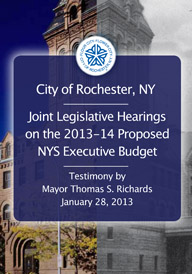 City of Rochester
City of Rochester
News Release
(Monday, Jan. 28, 2013) – Mayor Thomas S. Richards traveled to Albany today to provide testimony to the State Legislature on the Governor’s 2013-14 Proposed Executive Budget. Mayor Richards discussed Rochester’s financial situation in relation to the Governor’s budget proposals, calling the Real Property Tax as the traditional source of funding for cities an “18th century model that is incapable of dealing with 21st century realities.”
Mayor Richards thanked Governor Cuomo and the Legislature for approving the new Tier VI pension plan that will save Rochester millions of dollars in the years ahead. He also thanked them for providing funding that resulted in a $96.2 million award to the Finger Lakes Regional Economic Development Council, noting that this would help with the development of the Midtown Rising site, College Town at the University of Rochester and other projects.
The Mayor also thanked Governor Cuomo and the Legislature for the $15 million one-time spin up in state aid that they provided last year. He also praised the Governor’s stable rate pension proposal adjustment that could save the city up to $21 million. However, the Mayor told the committees that long term changes are needed in the way Upstate cities are funded as a solution to their recurring budget shortfalls. He said cities need more help in the form of increased aid from the state as well as a reduction in the expense burdens placed on them.
The City’s pension payments have increased by $77.5 million cumulatively over the last four years and will be $52 million in the next fiscal year. This amount, when combined with the state mandated payment to the school district, exceeds the City’s entire property tax revenue, plus millions more. This is the structural financial imbalance that most Upstate cities are dealing with. “It’s not a matter of raising taxes,” he said. “A 2% increase in property taxes will produce a little over $3.2 million in a year in which we have a $28 million shortfall. If it weren’t for state aid and the sales tax that pays for everything else, we would have been broke long ago.”
Rochester began its planning for the 2013-14 fiscal year facing a $42.7 million budget gap. By managing and reducing capital expenses, creating a self-insured health care plan where the unions and the City share in the financial risk, instituting an early retirement program and reducing employment, the City has taken these and other pro-active measures to reduce the gap to $27.9 million.
The Mayor said that while cities’ revenue models have grown antiquated, the demand for services in cities has increased. “Rochester, despite its reputation and general circumstances has some of the highest concentrations of poverty in the country,” the Mayor said. “Since those concentrations are in the cities, we are carrying the load for the whole region. If our citizens don’t get services from us, they don’t get them at all.”
“To be successful in rebuilding Upstate New York, we cannot ignore its cities and their archaic revenue sources,” the Mayor continued. “They are still the centers of economic and social activity. They are still where the people are and they are still where the needs are. Woe unto us if we try to succeed in Upstate New York by ignoring the cities.”
The Mayor suggested that greater investment in cities by the state would protect their significant investments in education and that the state should consider sharing in the City’s expense burdens, specifically its $119.1 million, mandated school payment and its public safety costs. “The state invests billions in education in recognition of the needs of urban children as a result of the environments in which they live,” he said. “It makes no sense to continue to invest so heavily in the school system while allowing the communities in which the children live to deteriorate.”
The Mayor also repeated Rochester’s call for per capita AIM funding to be equal to that of Buffalo’s since “the financial and demographic factors that justify it are now much the same between us,” he said. “This alone would provide Rochester with an additional $41.7 million.”
The Mayor said that while the Governor’s budget proposal had clear advantages and would help cities survive in the short term without doing significant damage to essential services, he said that more investment in cities was needed. “If Upstate cities are to be successful—given their age, given their concentrations of poverty and given all of the demographic issues that we know to be true—we must continue to invest in them and maintain their service levels…and if we back off, they’ll soon deteriorate.”
-30-
News Media: For more information, contact City Deputy Communications Director Michael Keane at 428-7135.